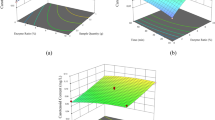Abstract
In black tea manufacturing, one of the most important steps is fermentation which influences the quality of tea. The macerated tea leaves were fermented at various temperatures (20, 25, 30, 35 °C) for different duration. Changes in polyphenoloxidase and peroxidase activities, depletion patterns of individual catechins, differences in individual theaflavin levels and formation of thearubigins were measured in leaves during fermentation. Higher stability of polyphenoloxidase and peroxidase enzymes was observed at lower temperature (20 °C), and increase in temperature, led to enzyme instability. The rate of degradation of all the catechins was found to be fastest at 35 °C and slowest at 20 °C. The formation and depletion of individual theaflavins varied with temperature and fermentation duration. The time required for the formation of maximum total theaflavins (TF) was highest at lower temperature and this time duration also varied for different theaflavins formation. Maximum amount of thearubigins (TR) content and liquor colour development was observed at 35 °C, and decrease in temperature reduced thearubigins accumulation. However, maximum brightness as well as TF/TR ratio was obtained at 20 °C, which suggests that fermentation at lower temperature is suitable for manufacturing quality black tea.




Similar content being viewed by others
References
Bajaj KL, Anan T, Tsushida T, Ikegaya K (1987) Effects of (−) epicatechin on oxidation of theaflavins by polyphenol oxidase from tea leaves. Agric Biol Chem 51:1767–1772
Biswas AK, Sarkar AR (1973) Biological and chemical factors affecting the valuations of North-East Indian Plains teas. II.- Statistical evaluation of the biochemical constituents and their effects on briskness, quality and cash valuations of black teas. J Sci Food Agric 24:1457–1477
Chunlei MA, Liang C (2007) Research progress on isolation and cloning of functional genes in tea plants. Front Agric China 1:449–455
Cloughley JB (1980) The effect of fermentation temperature on the quality parameters and price evaluation of Central African black teas. J Sci Food Agric 31:911–919
Ding Z, Kuhr S, Engelhardt UH (1992) Influence of catechins and theaflavins on the astringent taste of black tea brews. Z Lebensm Unters Forsch 195:108–111
Hara Y, Luo SJ, Wickremashinghe RL, Yamanishi T (1995) Biochemistry of processing black tea. Food Rev Int 11:457–471
Hilton PJ, Ellis RT (1972) Estimation of market value of Central African Tea by Theaflavin analysis. J Sci Food Agric 23:227–232
Liang Y, Lu J, Zhang L, Wu S, Wu Y (2003) Estimation of black tea quality by analysis of chemical composition and colour difference of tea infusions. Food Chem 80:283–290
Mahanta PK, Boruah SK, Boruah HK, Kalita JN (1993) Changes of Polyphenol Oxidase and Peroxidase activities and pigment composition of some manufactured black teas (Camellia sinensis L.). J Agric Food Chem 41:272–276
Ngure FM, Wanyoko JK, Mahungu SM, Shitandi AA (2009) Catechins depletion patterns in relation to theaflavin and thearubigins formation. Food Chem 115:8–14
Obanda M, Owuor PO, Mangoka R (2001) Changes in the chemical and sensory quality parameters of black tea due to variations of fermentation time and temperature. Food Chem 75:395–404
Owour PO, Obanda M (2001) Comparative responses in plain black tea quality parameters of different tea cultivars to fermentation temperature and duration. Food Chem 72:319–327
Owuor PO, Mcdowell I (1994) Changes in theaflavins composition and astringency during black tea fermentation. Food Chem 51:251–254
Owuor PO, Obanda M (1995) Clonal variation in the individual theaflavins and their impact on astringency and sensory evaluation. Food Chem 54:273–277
Owuor PO, Reeves SG (1986) Optimising fermentation time in black tea manufacture. Food Chem 21:195–203
Ravichandran R, Parthiban R (1998) Changes in enzyme activities (polyphenoloxidase and phenylalanine ammonia lyase) with type of tea leaf and during black tea manufacture and the effect of enzyme supplementation of dhool on black tea quality. Food Chem 62:277–281
Roberts EAH (1962) Economic importance of flavonoid substances. In: Geissman TA (ed) Chemistry of flavonoid compounds. Pergamon Press, Oxford, pp 468–512
Roberts EAH, Smith RF (1963) Phenolic substances of manufactured tea. II. Spectrophotometric evaluation of tea liquors. J Sci Food Agric 14:689–700
Robertson A (1983) Effects of physical and chemical conditions on the in vitro oxidation of tea leaf catechins. Phytochemistry 22:889–896
Sanderson GW, Berkowitz JE, Co H, Graham HN (1972) Biochemistry of tea fermentation: products of the oxidation of tea flavanols in a model tea fermentation system. J Food Sci 37:399–404
Sanderson GW, Ranadive AS, Eisenberg LS, Farrel FJ, Simon R, Manley CH, Coggon P (1976) Contributions of polyphenolic compounds to the taste of tea. ACS Symp Ser 26:14–46
Thanaraj SNS, Seshadri R (1990) Influence of polyphenoloxidase activity and polyphenol content of tea shoot on quality of black tea. J Sci Food Agric 51:57–69
Tufekci M, Guner S (1997) The determination of optimum fermentation time in Turkish black tea manufacture. Food Chem 60:53–56
Yao L, Jiang Y, Datta N, Singanusong R, Liu X, Duan J, Raymont K, Lisle A, Xu Y (2004) HPLC analysis of flavanols and phenolic acids in the fresh young shoots of tea (Camellia sinensis) grown in Australia. Food Chem 84:253–263
Acknowledgments
This work was funded by the Tea Board of India (Ministry of Commerce & Industry, Government of India) in the form of a research project [no. IRL-21(20)/2007-P-I] during XI th Plan period.
Author information
Authors and Affiliations
Corresponding author
Rights and permissions
About this article
Cite this article
Samanta, T., Cheeni, V., Das, S. et al. Assessing biochemical changes during standardization of fermentation time and temperature for manufacturing quality black tea. J Food Sci Technol 52, 2387–2393 (2015). https://doi.org/10.1007/s13197-013-1230-5
Revised:
Accepted:
Published:
Issue Date:
DOI: https://doi.org/10.1007/s13197-013-1230-5




